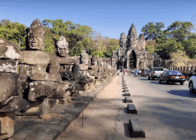Hoi An’s Japanese Bridge is a timeless piece of history that has captivated travelers from around the globe. Whether you’re a travel enthusiast, a history buff, or a photography lover, this iconic landmark offers something truly special for everyone. Join us as we explore the allure of the Japanese Bridge and uncover why it remains a must-visit attraction in Vietnam.
Historical Significance and Origin
The Japanese Bridge, also known as Chùa Cầu, was constructed in the early 17th century by the Japanese community residing in Hoi An. This architectural marvel was built to connect the Japanese quarter with the Chinese quarter, symbolizing not only a physical but also a cultural link between the two communities. The bridge’s construction was also believed to calm the spirits of a mythical dragon whose head was situated in India and tail in Japan, according to local folklore.
Over the centuries, the bridge has undergone several restorations, each adding to its charm and historical richness. Originally built with a roof to protect against the elements, the bridge has retained most of its original design and structure. The Japanese Bridge stands as a testament to Hoi An’s multicultural heritage and its role as a bustling trading port during ancient times.
Architectural Features and Unique Design Elements
A closer look at the Japanese Bridge reveals a fascinating blend of architectural styles, showcasing Japanese, Chinese, and Vietnamese influences. The most striking feature is its ornate roof, which is covered with precision-cut tiles and adorned with intricate carvings of mythical creatures, including dragons and dogs, symbolizing protection and strength.
The bridge is supported by robust wooden piers, and its floor is constructed from stone, offering durability and stability. One of the unique design elements is the small temple located at the center of the bridge, dedicated to the deity Tran Vo Bac De, the God of Weather. This temple is an example of the harmonious blend of spirituality and everyday functionality that characterizes the bridge.
Walking across the bridge, visitors can admire detailed engravings and wooden sculptures, which have been meticulously preserved over the centuries. The architectural charm of the Japanese Bridge lies in its symmetry, balance, and the seamless fusion of different cultural elements.
The Role of the Bridge in Local Culture and Community
Beyond its architectural beauty and historical significance, the Japanese Bridge holds a special place in the hearts of Hoi An’s residents. It has become more than just a tourist attraction; it is a symbol of the town’s enduring spirit and multicultural identity.
Local traditions and festivals often center around the bridge. For instance, the Full Moon Festival, held monthly, sees the bridge and surrounding areas illuminated with thousands of lanterns, creating a magical atmosphere that attracts both locals and tourists. Stories passed down through generations speak of the bridge as a place where young lovers would meet, and where important community decisions were once made.
The Japanese Bridge serves as a daily reminder of Hoi An’s rich history and its ability to bring people together. It is a living monument that continues to inspire pride and unity among the local community.
Practical Information for Visitors
Planning a visit to the Japanese Bridge? Here’s everything you need to know to make the most of your trip:
Best Times to Visit: The bridge is most enchanting during the early morning or late afternoon when the crowds are thinner and the light is perfect for photography.
Entry Fees: The bridge itself is free to walk across, but a small fee is required to enter the adjoining Old Town area. This fee helps with the preservation of historic sites, including the bridge.
Nearby Attractions: Don’t miss out on exploring the rest of Hoi An’s Old Town, a UNESCO World Heritage site. Other nearby attractions include the Hoi An Market, where you can sample local delicacies, and the Assembly Hall of the Fujian Chinese Congregation, known for its stunning architecture.
Personal Experiences and Photography Tips
Capturing the essence of the Japanese Bridge through photography requires a bit of planning and creativity. Here are some tips to help you get the perfect shot:
Golden Hour Magic: Visit during the golden hours—shortly after sunrise or before sunset. The soft, warm light will enhance the colors and details of the bridge.
Vary Your Angles: Don’t just stick to the usual frontal shots. Try capturing the bridge from different angles, including side views and close-ups of the intricate carvings.
Include the Surroundings: Incorporate the lush greenery and water reflections in your photos to add depth and context.
Engage with Locals: Sometimes, the best stories come from the people you meet. Engage with locals and capture candid moments that reflect the bridge’s role in everyday life.
Conclusion
The Japanese Bridge in Hoi An is more than just a historical landmark; it is a gateway to understanding the town’s rich cultural tapestry and a source of inspiration for all who visit. Whether you are there to marvel at its architectural beauty, learn about its storied past, or capture its essence through your lens, the Japanese Bridge offers an experience that is both enriching and unforgettable.
Hoi An is a charming ancient town, and the Japanese Bridge Hoi An is one of the most beautiful and significant attractions in the city. The bridge is a unique piece of architecture that showcases the essence of the Japanese merchants who once lived in Hoi An. It stands as a symbol of peace, harmony and friendship between nations. Today, locals and visitors alike visit the bridge and the nearby Fujian Assembly Hall for their architectural beauty, historical significance and cultural value. Whether you are a history enthusiast, architecture lover, or simply looking for a beautiful place to capture your memories, the Japanese Bridge Hoi An is a must-visit attraction that should not be missed.
Ready to explore the Japanese Bridge yourself? [Book a call] with one of our local guides to get personalized tips and make the most of your visit to Hoi An.
By immersing yourself in the history, culture, and beauty of the Japanese Bridge, you’ll come away with a deeper appreciation for this timeless wonder and the vibrant community it continues to inspire.
- Uncover Cambodia’s Hidden Charms 6 Days / 5 Nights (121 views)
- The Best Exotic Vietnam – 16 Days / 15 Nights (111 views)
- Seamless Cruise: Halong Bay to Da Nang – Fostering smooth travel experience from Halong Bay to Da Nang. (51 views)
- Vietnam Culinary Tour: Your Definitive Guide to a Food Lover’s Journey (48 views)
- Top Vietnam Tour Operators – The Ultimate Guide to the Best Tour Companies for Vietnam (48 views)


























